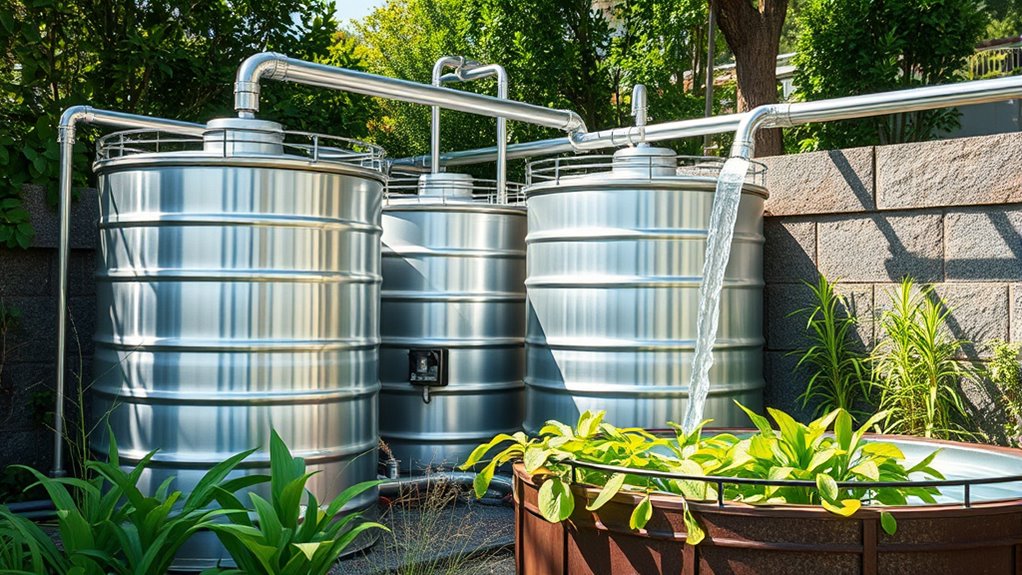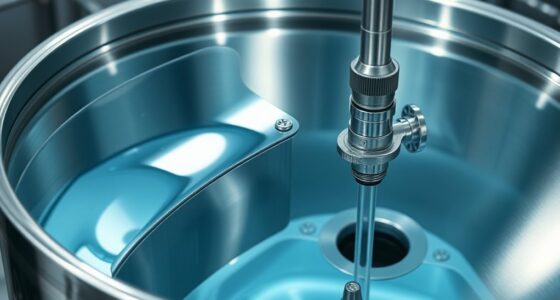Effective water stewardship involves managing backwash waste properly through techniques like evaporation ponds or treatment, reusing treated water to cut costs and conserve resources, and capturing rainwater with careful collection, storage, and filtration systems. By implementing these strategies, you can reduce environmental impact, lower water bills, and promote sustainability. Understanding best practices in backwash disposal, water reuse, and rain capture helps create more resilient systems—keep exploring to learn how you can make a significant impact.
Key Takeaways
- Effective backwash management involves controlling flow rate, timing, and proper disposal methods to prevent environmental contamination.
- Water reuse strategies, such as recycling backwash water and treated stormwater, conserve resources and reduce wastewater discharge.
- Rainwater harvesting methods include rooftop collection, filtering, and storage in tanks, ensuring water safety through regular maintenance and treatment.
- Proper disposal of backwash waste uses methods like evaporation ponds and underground injection wells, tailored to waste composition and regulations.
- Integrated water stewardship promotes sustainability by combining backwash treatment, reuse initiatives, and rain capture to optimize water resource management.
Understanding Backwash Management in Water Systems

Have you ever wondered what happens to the water used to clean filters in water treatment systems? When filters become clogged, backwashing is necessary to remove debris and restore system efficiency. During backwash, water flows in reverse through the filter, dislodging trapped particles. Managing this waste water is vital because it contains dirt, organic matter, and potentially harmful contaminants. Proper backwash management involves controlling the flow rate, timing, and frequency to minimize environmental impact. You need to monitor these processes carefully to prevent excess waste and contamination. Additionally, treatment of backwash water may be required before disposal to ensure it doesn’t harm local ecosystems. Implementing filtration maintenance practices can further improve system longevity and effectiveness. Effective management ensures your water system stays efficient and environmentally responsible, reducing waste and promoting sustainability.
Techniques for Effective Backwash Waste Disposal
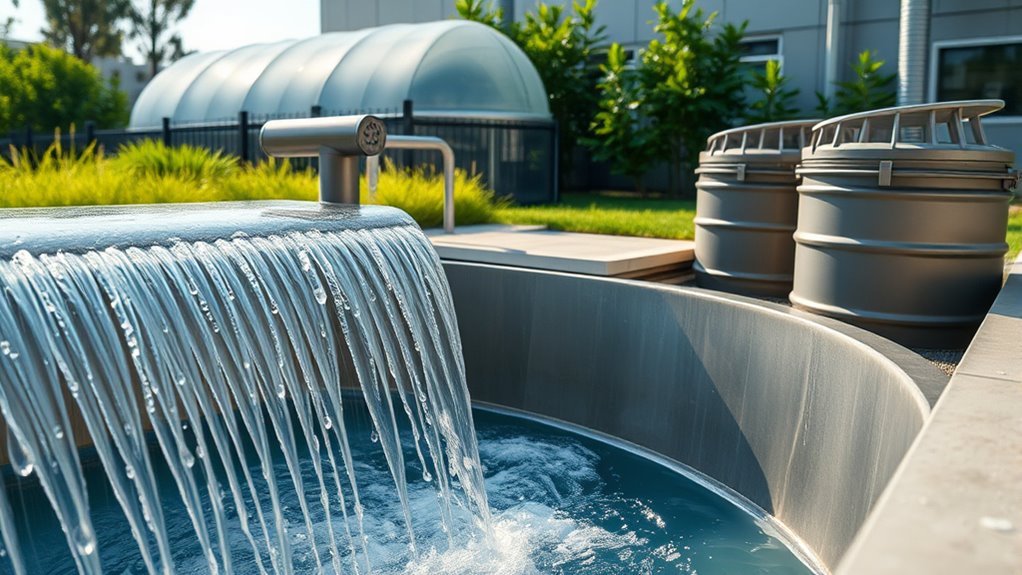
Effective disposal of backwash waste is key to maintaining both system efficiency and environmental health. Proper techniques prevent contamination, reduce hazards, and guarantee compliance with regulations. One effective method is directing the waste into lined evaporation ponds, where water naturally evaporates, leaving solids behind. Alternatively, you can filter the waste to separate solids for safe disposal or reuse. Using underground injection wells allows you to inject waste deep into suitable geological formations, minimizing surface impact. Another approach involves treating the waste through chemical or biological processes before disposal, ensuring contaminants are neutralized. Proper asset division considerations during disposal can help prevent future legal disputes related to water rights and property. Visualize these techniques as:
Proper backwash waste disposal ensures environmental safety and maintains system efficiency through techniques like evaporation ponds and chemical treatment.
- Lined ponds with evaporation processes
- Filtration systems separating solids
- Deep injection wells into geological layers
- Chemical treatment units neutralizing pollutants
Choosing the right technique depends on waste volume, composition, and local regulations.
Benefits of Reusing Treated Water in Industrial Processes

Reusing treated water in industrial processes offers significant benefits by conserving freshwater resources and reducing overall water consumption. When you reuse water, you lessen the demand on local water sources, helping to preserve ecosystems and reduce strain on municipal supplies. It also lowers your operational costs since treating new water is often more expensive than recycling existing supplies. Additionally, reusing water minimizes wastewater discharge, decreasing potential environmental impacts and compliance costs. You can implement closed-loop systems or recycle water within specific processes, increasing efficiency and sustainability. This approach not only supports environmental stewardship but also enhances your company’s reputation as a responsible business. Proper management of water quality, including maintaining appropriate color accuracy, is crucial to prevent process disruptions and ensure optimal performance. Overall, reusing treated water helps you achieve greater resource efficiency while supporting long-term industrial sustainability.
Strategies for Implementing Water Reuse in Municipal Settings
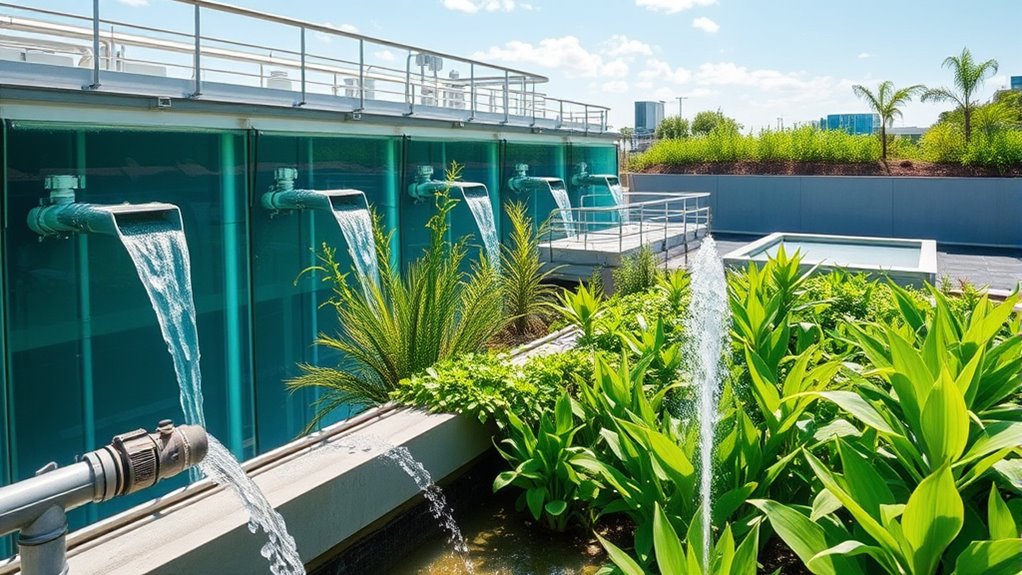
Implementing water reuse in municipal settings requires a strategic approach that integrates planning, infrastructure, and community engagement. You need to assess local water needs, identify suitable reuse options, and develop a clear implementation plan. Upgrading infrastructure is essential—installing treatment facilities, pipelines, and storage tanks to handle recycled water safely and efficiently. Engaging the community helps build support and awareness, ensuring acceptance and proper use. Visualize the process as:
- Constructing dedicated pipelines connecting treatment plants to public spaces
- Installing advanced filtration systems to ensure water quality
- Creating public education campaigns about reuse benefits
- Designing user-friendly distribution points for recycled water
- Ensuring water quality standards are maintained through continuous monitoring and proper testing procedures
Rainwater Harvesting: Methods and Best Practices
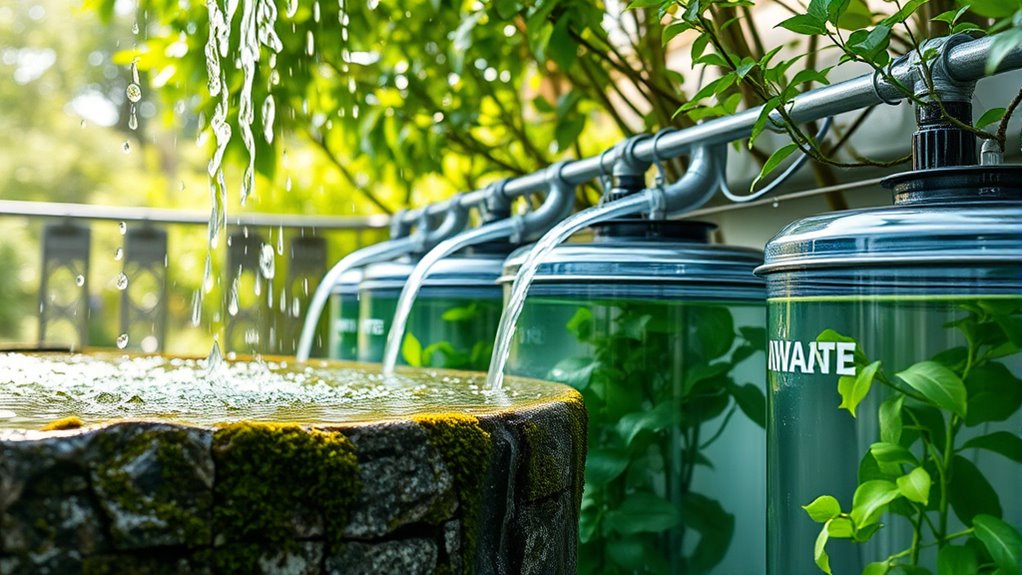
Building on strategies for water reuse, rainwater harvesting offers a practical way to supplement municipal water supplies and reduce reliance on centralized systems. To get started, identify suitable catchment areas like rooftops or paved surfaces that collect rainwater efficiently. Use first flush diverters to remove debris and contaminants before water enters storage tanks. Install screens or filters to prevent debris from clogging pipes and outlets. Ensure your storage tanks are opaque to prevent algae growth and are tightly sealed to avoid contamination. Regular maintenance, such as cleaning screens and inspecting for leaks, keeps your system functioning at its best. Prioritize safety by treating harvested water if intended for drinking or cooking. Incorporating efficient payment solutions can streamline the management of rainwater harvesting systems, especially for large-scale or community projects. Following these best practices maximizes rainwater harvesting’s benefits while safeguarding your health and the environment.
Designing Infrastructure for Rainwater Capture and Storage
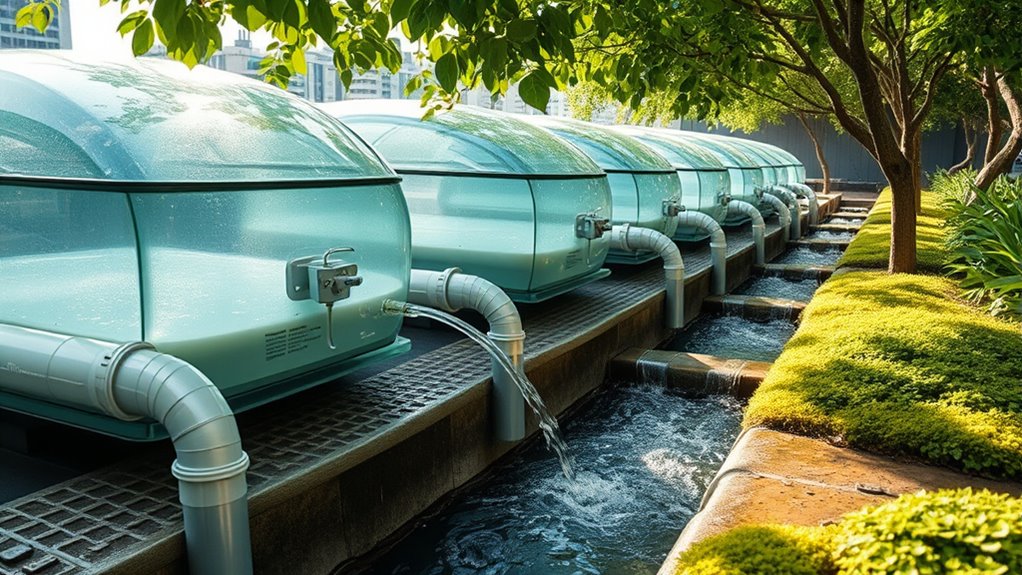
When designing infrastructure for rainwater capture and storage, you should carefully plan your catchment area to maximize runoff collection. You’ll need to choose storage systems that fit your needs and guarantee they’re safe and easy to maintain. Regular upkeep and safety checks are essential to keep your system effective and reliable over time. Incorporating proper storage capacity considerations ensures the system can handle varying rainfall amounts and prevents overflow or shortages.
Catchment Area Design
Designing an effective catchment area begins with understanding how to optimize rainwater collection and storage. You need to identify the best surfaces to direct rainfall, such as rooftops or paved areas, ensuring they are clean and free of contaminants. Proper grading is essential to channel water efficiently toward collection points. Consider the placement of gutters and downspouts to reduce overflow and prevent erosion. Incorporate features that minimize debris entry, like screens or filters. Visualize:
- Sloped surfaces guiding water seamlessly toward collection zones
- Strategically positioned gutters directing flow away from erosion-prone areas
- Barriers or screens catching leaves and debris before entering storage
- Clear pathways that facilitate maintenance and inspection
- Rainwater harvesting systems designed to maximize efficiency and water quality
This approach maximizes water capture while protecting your infrastructure.
Storage System Options
Choosing the right storage system is essential for maximizing your rainwater harvesting efforts. You need a container that suits your water volume, space, and budget. Options include above-ground tanks, which are easy to install and maintain, and underground reservoirs, which save space and protect water quality. Material choices matter; polyethylene tanks are durable and affordable, while concrete and metal tanks offer longevity and strength. Consider whether you want a modular system that can expand over time or a single, large tank for higher capacity. Guarantee your system includes proper fittings for inlet and outlet connections, as well as overflow protection. Properly sized and selected storage assures reliable water supply, reduces runoff, and helps you make the most of your rainwater harvesting setup. Material selection is crucial in determining the durability and longevity of your storage system.
Maintenance and Safety
To guarantee your rainwater harvesting system remains safe and functional, proper maintenance and safety measures are essential from the start. Regular inspections prevent clogs, leaks, and contamination, ensuring your system runs efficiently. Keep gutters clear of leaves and debris, and check for rust or damage in pipes and tanks. Safety-wise, install screens to prevent mosquito breeding and consider covers to avoid accidental falls. Make sure all components are properly grounded to prevent electrical hazards if using pumps. Additionally, monitor water quality regularly to avoid health risks. Visualize a system with clean gutters, secure lids, and sturdy piping—these details protect both your investment and your health. Implementing proper safety protocols can further enhance the longevity and safety of your rainwater harvesting setup. Maintaining your system diligently guarantees safe, reliable rainwater collection for years to come.
Environmental and Economic Advantages of Rainwater Utilization
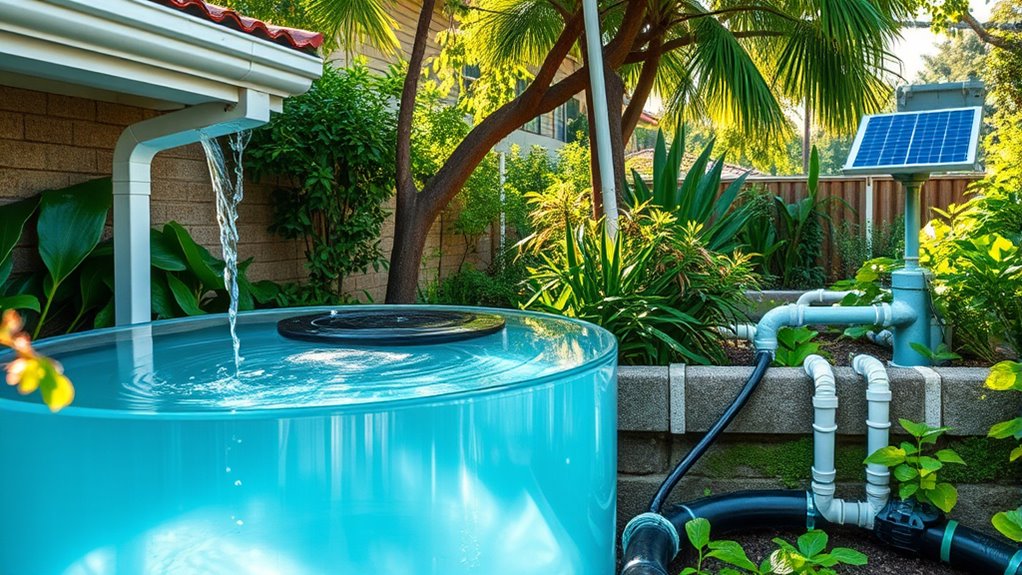
Utilizing rainwater offers significant environmental and economic benefits that can enhance sustainability and reduce costs. By capturing rain, you decrease reliance on municipal water supplies, which conserves energy and reduces your carbon footprint. Rainwater is a free, renewable resource, lowering your water bills and providing an affordable alternative for irrigation, flushing, or cooling systems. Environmentally, rainwater reduces stormwater runoff, decreasing erosion and pollution in local waterways. Using rainwater can also mitigate the risks associated with seed allergy cross-reactivity, especially when selecting non-chemical or untreated sources. Economically, investing in rain harvesting systems can lead to long-term savings and potential tax incentives. Additionally, using rainwater eases pressure on municipal infrastructure, promoting community resilience. Overall, adopting rainwater utilization aligns with eco-friendly practices while offering tangible financial advantages, making it a smart choice for sustainable water management.
Overcoming Challenges in Water Stewardship Practices

While rainwater harvesting offers clear environmental and economic benefits, implementing these practices often presents challenges that must be addressed. You might face issues like limited space for storage, which restricts how much water you can collect and use. Ensuring water quality can also be difficult, as contaminants may enter your system without proper filtration. Additionally, you may encounter resistance from local regulations or lack of awareness among community members. Infrastructure costs can be high upfront, making it tough to justify initial investments. Weather variability impacts collection efficiency, especially during dry seasons. To overcome these hurdles, you need strategic planning, community engagement, and innovative solutions, such as compact storage options or filtration systems, to make water stewardship both feasible and sustainable.
Case Studies Demonstrating Successful Water Conservation Initiatives
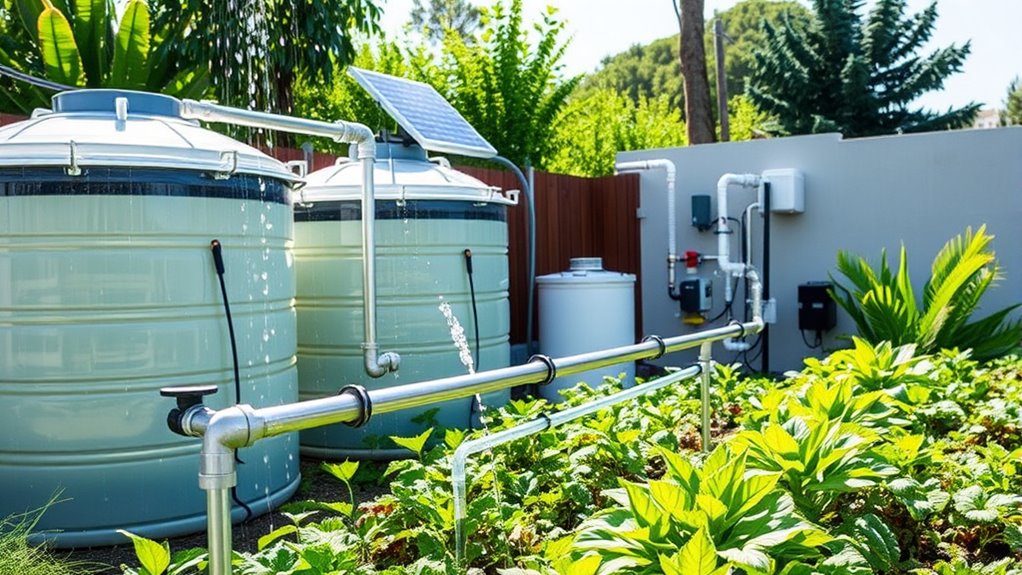
You can see how industrial backwash recycling reduces water waste and lowers operational costs through real-world examples. Urban rainwater harvesting projects demonstrate how cities are capturing and utilizing stormwater to meet community needs. These initiatives highlight practical strategies that you can implement to improve water conservation efforts.
Industrial Backwash Recycling
By recycling backwash water in industrial processes, you can considerably cut down on freshwater use and reduce wastewater output. This approach not only conserves resources but also lowers treatment costs and environmental impact. Successful case studies showcase factories implementing closed-loop systems, capturing backwash, and repurposing it for cleaning, cooling, or processing. Imagine:
- Pipes and tanks seamlessly integrated with filtration units
- Automated systems continuously monitoring water quality
- Storage tanks filling with recycled water for repeated use
- Operators overseeing efficient, sustainable workflows
These initiatives demonstrate how innovative recycling methods lead to tangible savings. By adopting backwash recycling, you contribute to water conservation efforts while boosting operational efficiency. It’s a practical, impactful strategy that aligns economic benefits with environmental responsibility.
Urban Rainwater Harvesting
Urban rainwater harvesting has become a vital strategy for cities aiming to reduce reliance on freshwater sources and promote sustainable water use. By capturing rainwater from rooftops and paved surfaces, you can greatly decrease stormwater runoff and ease pressure on municipal supplies. Case studies show that implementing simple collection systems, such as rooftop tanks and permeable pavements, can supply water for irrigation, toilets, and even drinking after proper treatment. For example, in Chennai, residents installed rainwater harvesting systems that recharge groundwater and reduce dependence on city supplies. Similarly, in Los Angeles, community projects have successfully used rain barrels to support urban greenery. These initiatives demonstrate how urban rainwater harvesting not only conserves water but also enhances resilience against droughts and climate variability.
Frequently Asked Questions
How Do Backwash Practices Impact Local Water Quality and Ecosystems?
Backwash practices can negatively impact local water quality and ecosystems if not managed properly. You might introduce contaminants like chemicals, debris, or pathogens into natural water sources, harming aquatic life and reducing water clarity. Improper disposal or overuse of backwash water can lead to pollution and habitat disruption. To minimize these impacts, you should treat and responsibly dispose of backwash water, ensuring it doesn’t pollute surrounding ecosystems.
What Are the Latest Innovations in Water Reuse Technology?
You can implement advanced water reuse technologies like membrane bioreactors and smart filtration systems, which efficiently treat wastewater for multiple purposes. Innovations include decentralized graywater systems, UV disinfection, and real-time monitoring sensors that optimize reuse processes. These technologies reduce your reliance on freshwater sources, cut costs, and promote sustainability. By adopting these innovations, you actively contribute to conserving water, protecting ecosystems, and creating more resilient water management practices.
How Can Rainwater Harvesting Be Integrated Into Urban Infrastructure?
Imagine a city where rooftops funnel rainwater into underground tanks, reducing strain on the sewer system. You can integrate rainwater harvesting by installing catchment systems on buildings, connecting them to storage tanks, and utilizing the water for landscaping or non-potable uses. Urban planners can design streets with permeable pavements to enhance infiltration. This approach conserves water, decreases runoff, and supports sustainable city living.
What Policies Support Sustainable Water Stewardship at the Community Level?
You can support sustainable water stewardship at the community level by advocating for policies that promote rainwater harvesting, incentivize water reuse, and protect local water sources. Encourage local governments to implement regulations that facilitate easy access to rainwater systems and provide subsidies or grants for installation. Educate residents about conservation practices, and push for zoning laws that incorporate green infrastructure to guarantee responsible water management and resilience for your community.
How Do Economic Incentives Motivate Adoption of Water Recycling Methods?
You’d be surprised to learn that cities offering tax breaks for water recycling see a 30% increase in adoption. Economic incentives motivate you by reducing costs and boosting savings, making sustainable methods more appealing. When rebates or credits are available, you’re more likely to invest in backwash systems, reuse technologies, or rain capture solutions. These incentives turn eco-friendly choices into financially smart moves, encouraging widespread adoption and better water stewardship.
Conclusion
By embracing water stewardship, you hold the key to a sustainable future—like a gardener tending to a fragile seed. With mindful backwash management, thoughtful reuse, and rain capture, you nurture a cycle that sustains life and preserves resources. Each action is a drop contributing to the ocean of change. Remember, your commitment is the rain that nourishes the roots of our planet, ensuring growth for generations to come.
